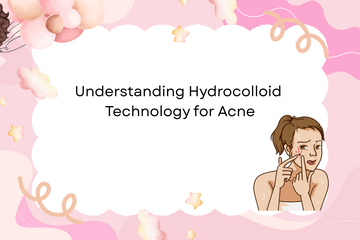Acne is a common skin condition that affects people of all ages. While many people struggle to find effective treatments, one solution that has gained significant popularity in recent years is the use of hydrocolloid patches. Hydrocolloid patches, also known as non-medicated acne patches, are a safe and effective way to treat acne spots without the use of harsh chemicals. In this article, we will delve into the technology behind hydrocolloid patches and explain how they work to help heal acne.
What is Hydrocolloid Technology?
Hydrocolloid is a type of material that is used for wound care and has properties that promote healing. It is a gel-forming substance that is made from various materials such as sodium carboxymethyl cellulose, pectin, and gelatin. When applied to the skin, hydrocolloid creates a moist environment that aids in the healing process by absorbing excess moisture and helping to protect the wound from external contaminants. This technology is now being used in acne patches to help reduce inflammation and accelerate healing.
If you're curious about how acne patches differ in type and function, this detailed guide on what is an acne patch and how does it work explains the types of acne patches and their benefits.
How Hydrocolloid Patches Work for Acne
Hydrocolloid acne patches work as a spot treatment for acne by absorbing the pus from pimples. These patches create a barrier that helps to reduce the size of the pimple by pulling out the fluids and impurities that contribute to inflammation. When you apply a hydrocolloid patch over an acne spot, it acts as a protective shield, preventing bacteria from entering and causing further irritation. This process also prevents the urge to pick or pop pimples, which can lead to scarring.
These patches are typically thin, transparent, and adhesive, making them discreet and easy to wear throughout the day or night. Once applied, they adhere to the skin and stay in place, even during daily activities like talking or eating. The hydrocolloid material inside the patch draws out excess moisture from the acne while maintaining a moist environment that encourages faster healing.
Benefits of Using Hydrocolloid Acne Patches
- Non-medicated and gentle: Hydrocolloid patches do not contain harsh chemicals, making them ideal for individuals with sensitive skin. They are a non-medicated acne patch option that can be used daily without causing irritation.
- Reduces inflammation and redness: The patches help reduce swelling and redness by drawing out pus and other impurities, which can lead to a noticeable decrease in the size of pimples.
- Prevents picking and scarring: By covering the acne with a protective patch, hydrocolloid patches reduce the temptation to pick at the pimples. This helps prevent scarring and further irritation to the skin.
- Discreet and easy to use: These patches are transparent, so they can be worn discreetly under makeup or on their own, providing a hassle-free acne treatment that works quietly throughout the day or night.
- Promotes faster healing: The moist healing environment created by hydrocolloid patches accelerates the natural healing process, helping to heal pimples more quickly than without treatment.
How to Use Hydrocolloid Acne Patches
Using hydrocolloid acne patches is straightforward. Here's a simple guide:
- Cleanse your skin: Start by gently cleansing your face to remove any dirt, oil, or makeup. This ensures that the patch adheres properly to the skin.
- Dry your skin: Pat your skin dry with a clean towel. It's important to make sure the area around the acne spot is dry before applying the patch.
- Apply the hydrocolloid patch: Gently peel off the backing of the patch and apply it directly over the pimple. Press down slightly to ensure it sticks firmly.
- Leave it on: Let the patch stay on for several hours or overnight. During this time, it will absorb the fluids from the pimple and help speed up the healing process.
- Remove and dispose: After a few hours or when the patch has absorbed enough fluid, remove the patch and dispose of it properly. You will likely notice a reduction in the size and redness of the pimple.
Who Can Benefit from Hydrocolloid Acne Patches?
Hydrocolloid patches are suitable for individuals who have mild to moderate acne, especially those dealing with surface-level pimples or pustules. These patches are effective for people with sensitive skin as they are gentle and non-irritating. However, they may not be as effective for severe acne or cystic acne, which may require stronger treatments. If you are unsure about the right treatment for your acne, it's always best to consult a dermatologist.
Managing skin issues during menstruation can be even more difficult when you're also dealing with cramps. For natural, drug-free cramp relief, consider the Matri Pro Menstrual Pain Relief Device, which uses TENS technology to ease period pain naturally.
Common Misconceptions about Hydrocolloid Acne Patches
There are several misconceptions surrounding the use of hydrocolloid patches for acne. Let's clear them up:
- Myth 1: Hydrocolloid patches are only for big pimples
Hydrocolloid patches can work on both small and large pimples, not just the ones that are noticeable. They are effective for reducing inflammation and absorbing pus from any type of pimple. - Myth 2: Hydrocolloid patches are a one-size-fits-all solution
While hydrocolloid patches are effective, they are not a cure for all types of acne. They work best on surface-level pimples, not deep cystic acne, which may require a more comprehensive skincare regimen. - Myth 3: Hydrocolloid patches are a quick fix
While these patches can speed up the healing process, they work best as part of a broader acne treatment plan that includes a consistent skincare routine.
Choosing the right menstrual care products can impact your skin health, especially during hormonal breakouts. Learn how to find your fit with this guide on selecting the right menstrual cup size.
FAQs
1. What is the main benefit of hydrocolloid patches for acne?
The primary benefit of hydrocolloid patches is their ability to absorb pus from pimples and reduce inflammation. They create a moist environment that accelerates the healing process while protecting the area from further irritation, preventing picking, and promoting faster healing.
2. How long should I leave a hydrocolloid patch on my acne?
You can leave a hydrocolloid acne patch on for several hours or overnight, depending on your preference. Most people find that leaving it on overnight provides the best results, as it allows the patch to absorb fluid and promote healing while you sleep.
3. Can hydrocolloid patches be used for cystic acne?
No, hydrocolloid patches are not effective for treating cystic acne. They are best used for surface-level pimples and pustules. Cystic acne requires stronger treatment methods and might need the attention of a dermatologist.
4. Are hydrocolloid acne patches suitable for sensitive skin?
Yes, hydrocolloid acne patches are gentle and non-medicated, making them an excellent option for people with sensitive skin. The patches do not contain harsh chemicals, which helps prevent irritation.
5. Can I use makeup over a hydrocolloid patch?
Yes, you can apply makeup over a hydrocolloid acne patch. The patches are thin and transparent, making them discreet enough to wear under makeup without drawing attention. Just be sure to apply makeup gently so as not to disturb the patch.
6. Do hydrocolloid patches work for blackheads?
No, hydrocolloid patches are not designed for blackheads. They are most effective for inflamed pimples or pustules. Blackheads, which are clogged pores, may require other treatments like exfoliation or pore strips.
7. How often can I use hydrocolloid patches?
Hydrocolloid patches can be used daily as needed, especially for treating pimples. Just make sure to replace them once they've absorbed fluids or after several hours to ensure they remain effective.
8. Do hydrocolloid acne patches prevent new pimples from forming?
No, hydrocolloid acne patches are not designed to prevent new pimples from forming. They only help to treat existing pimples by absorbing pus and reducing inflammation.
9. Can I use hydrocolloid patches on broken skin?
No, you should avoid using hydrocolloid patches on broken or irritated skin. The patches are meant for treating pimples and should not be applied to open wounds or skin that has been damaged.
10. How long will it take to see results with hydrocolloid patches?
The results of using hydrocolloid acne patches can be visible within 24-48 hours, depending on the size and severity of the pimple. The patches reduce inflammation, and you may notice a reduction in the pimple's size and redness after a few applications.






